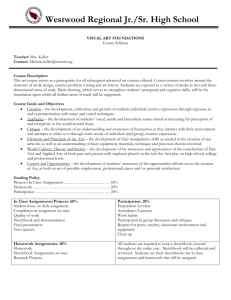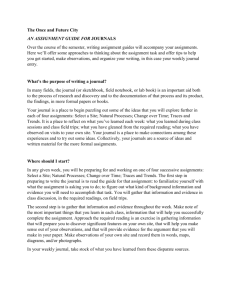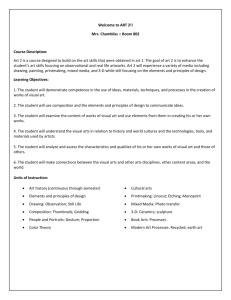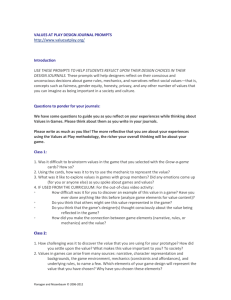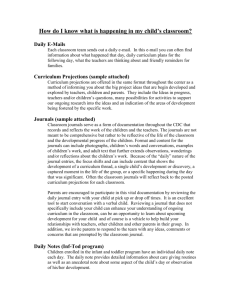Process Journals Lesson
advertisement
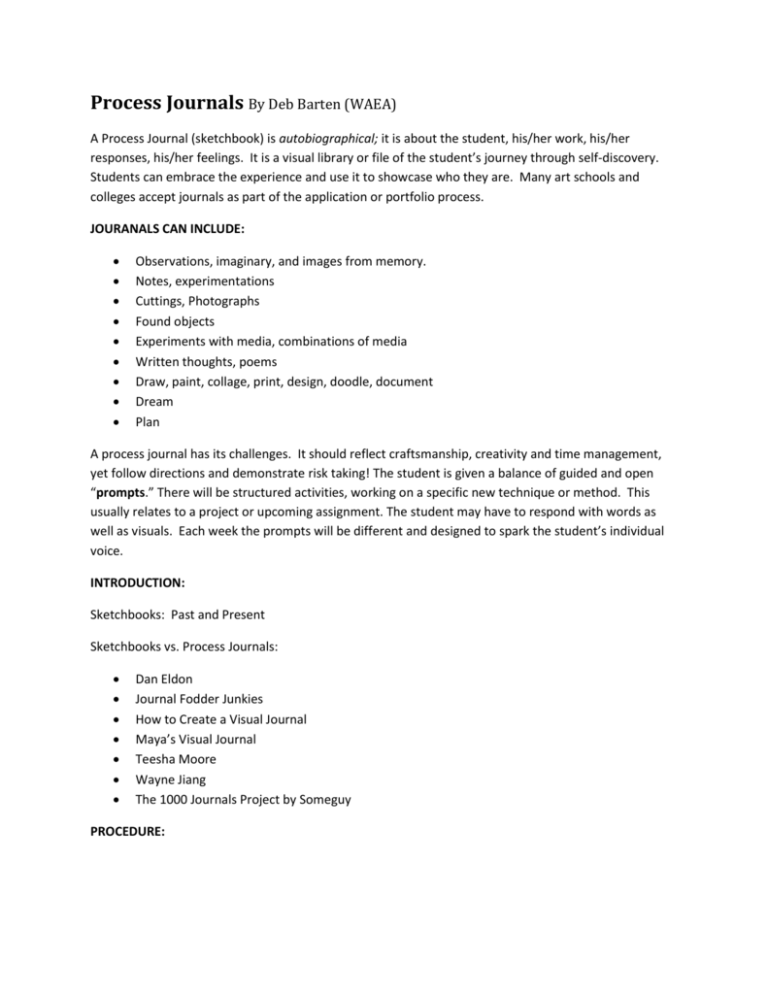
Process Journals By Deb Barten (WAEA) A Process Journal (sketchbook) is autobiographical; it is about the student, his/her work, his/her responses, his/her feelings. It is a visual library or file of the student’s journey through self-discovery. Students can embrace the experience and use it to showcase who they are. Many art schools and colleges accept journals as part of the application or portfolio process. JOURANALS CAN INCLUDE: Observations, imaginary, and images from memory. Notes, experimentations Cuttings, Photographs Found objects Experiments with media, combinations of media Written thoughts, poems Draw, paint, collage, print, design, doodle, document Dream Plan A process journal has its challenges. It should reflect craftsmanship, creativity and time management, yet follow directions and demonstrate risk taking! The student is given a balance of guided and open “prompts.” There will be structured activities, working on a specific new technique or method. This usually relates to a project or upcoming assignment. The student may have to respond with words as well as visuals. Each week the prompts will be different and designed to spark the student’s individual voice. INTRODUCTION: Sketchbooks: Past and Present Sketchbooks vs. Process Journals: Dan Eldon Journal Fodder Junkies How to Create a Visual Journal Maya’s Visual Journal Teesha Moore Wayne Jiang The 1000 Journals Project by Someguy PROCEDURE: Assignments will be given every ____________. The structure for the sketchbook/journal is based on 100% participation--the more techniques, concepts and development of ideas they explore, the more they gain from the experience. The following are the guidelines the teacher, Deb Barten, provides for her students regarding grading , the “rules”and how these assignments will work: The process journal averages out to be about a third of your overall grade. It will impact grade if you fail to do several of the assignments. If you welcome the experience with an open mind as a place to “go off the beaten path,” you will deepen you work in ways you hadn’t planned. We will have projects later in the year that are inspired from the Process Journals. Again it critical that you participate. You will work all period on the assignment. The completed assignment is due the following week on _______________. No exceptions. I will check your journal and have it ready for you on ___________and the next assignment. How you structure you class time is one of the problems I am throwing at you! You have the journal requirements and you will have your studio projects. Knowing how to work on both is another component of the journal. I see the journal as “homework” or when you are working out an idea, or have “wait time.” You can chose to work on your journal, but be mindful that you still have a project due as well; don’t let the journal become larger than life. Trust me it happens. GETTING STARTED: 1. Once your receive the sketchbooks, PUT YOUR NAME ON IT! Flip it over to the back. With a black marker write your FIRST and LAST name on the top left or right side. Please write so I can read it-human size and clarity. 2. You will be designing the cover as one of our first projects. Please don’t do anything until you are given the prompt. 3. Each assignment will be worth 25 points unless you hear otherwise. Some assignments may have more than one entry. 4. If you do not turn in the journal assignment, it is recorded as a zero. Unless you have an excused absence, no late journal entries will be accepted. It is due on______ . The journals will be placed in the bin marked with your period and course. The bin will be out and ready for you as you come in. It is due before you leave. 5. You will “get the hang” of the format really fast. It really is painless. Have fun with it. The main rule is you CAN NOT TEAR ANY PAPER from the sketchbook. If you mess up, work with it; figure a way to work with the problem. 6. Please do not submit work that is wet. Allow enough time for paint and glue to dry. In the past this caused some problems. I would go to open a journal, and the pages were all jammed--nasty! You know better than that. If this happens, I will take points away. 7. Share with each other. This studio is your community. Use your peers as resources within your community. The process journal is a wonderful method to record a collection of ideas. 8. I will respect your privacy. If you do not want an entry shared, I will honor that. I will always ask. 9. Due to holidays and weird schedules, the calendar may need to be adjusted from time to time. The dates with any changes will be posted. It will usually end up with an extension of an assignment by a week. PROMPTS: Small items will often be used as prompts. For Art I students, the wackier the better. The journal assignment is also meant to hook in students--especially those kids who love to cartoon and illustrate. Usually kids have their journals and supplies out for a specific entry. Then they are given a brief intro to the prompt and given the item. At first you may need to “prime the pump” a bit, but after a while they take it and go. Here are a few ideas… Safety Pin Stirring stick Frame for watercolor pans Origami paper Small paper umbrellas Band-aids Brads (drawing must have a moving part) Negative space-I will pre-cut a shape from one of their pages. They will “use the negative” on week and the following trace the shape on the next page and “use the positive”….it needs to work with the negative composition! A word or saying that is given to them Make a chop and create a design Using palette knives Drawing with alternative materials Washes with inks and coffee--one week do several pages. These pages will serve as background for other assignments Observational drawing of driftwood or interesting sticks using China Markers on wash page Golf balls and Tees--drawing using painters paper and pastels, China Markers Paint on interfacing (fabric store) Use the rubber waffle weave shelf material Print with sandpaper--color sand paper with crayons, iron from back to page. Use this texture, pattern as part of the design. If you have a few sewing machines in your room, students “sew” something to the page and work it Incorporate stitching into the drawing Illustrate the candy Smarties--take it apart, build with it, add characters….colored pencil Rubbings Flashcards--alphabet and numbers Rubber cement resist and oil pastels-o-bservational drawing of gourds Weaving “Jewels” Reflective paper Card size pieces of old watercolor painting
